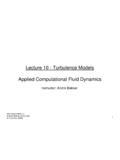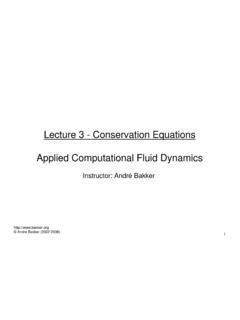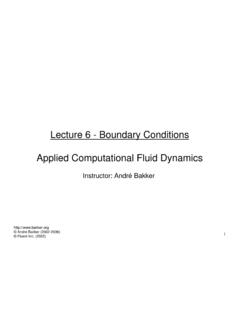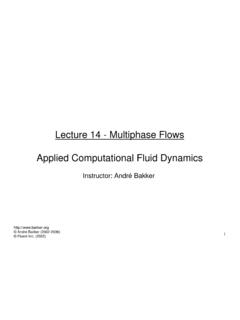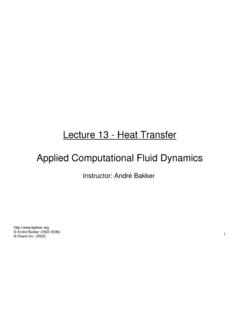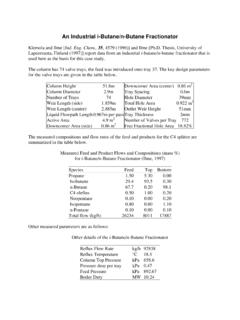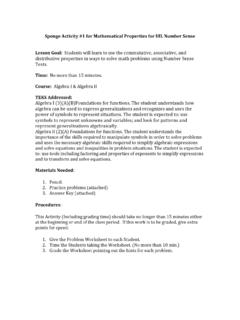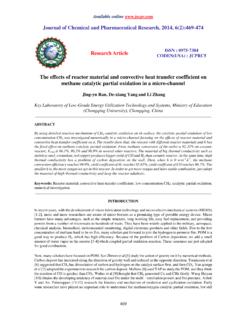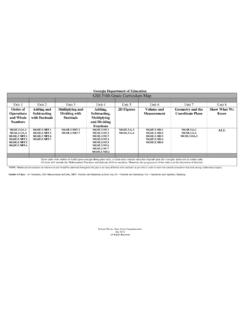Transcription of Fluent Inc. reactors CFD I - bakker.org
1 Reactor Design Andr Bakker, Ahmad H. Haidari and Elizabeth M. Marshall, Fluent Inc. designreactors viaCFD. I n addition to their work in the chemical and oil industries, chemical engineers (ChEs) are employed in a wide variety of other industries, such as the produc- tion of plastics and synthetic resins, man-made fibers, polymers, paints Using computational fluid dynamics to design commercial-size batch and continuous reactors can eliminate means of a chemical reaction in an environment that involves fluid flow. Depending upon the physical state of the materials being converted and the operating conditions, different types and scales of reactors are used. These include, but are not lim- and varnishes, drugs and pharma- ited to, batch; continuous stirred- ceuticals, agricultural chemicals, subjective experience tank reactors (CSTRs); plug-flow, fats and oils, foods and beverages, fluidized, fixed or moving-bed reac- and many others.
2 ChEs are respon- and empiricism, and tors; bubble columns or airlifts; and sible for the design, operation, opti-lead to better-designed, film reactors . In this article, some of mization and troubleshooting of today's most popular methods for manufacturing operations, and can more-efficient units. simulating reactive flow are re- be involved in applications that viewed. Examples will emphasize range from combustion to biological reactions. All of the variety of applications and methods for tackling this these industrial applications have one thing in common complex behavior. raw materials are converted into final products by To successfully implement a chemical reaction 30 December 2001 CEP.
3 Developed in the laboratory on an industrial scale, many When modeling chemical reactors using CFD, the hurdles are usually encountered. Often, these are related fluid-flow pattern and temperature field are calculated to difficulties in maintaining the same temperatures, from conservation equations for mass, momentum and pressures, and level of homogeneity of the reactants on a enthalpy. These equations can be found in textbooks and large scale. Furthermore, while the reaction time-con- will not be reiterated here. For reacting flows, the mix- stants stay the same on scaleup, other time constants ing and transport of chemical species must also be cal- change. Usually, there are significant differences be- culated using species-transport equations.
4 Each equation tween the residence, feed and mixing times in the labo- is a statement of conservation of a single species. Multi- ratory and those on the production floor. In addition to ple-species equations can be used to represent compo- scaleup issues, there is a strong interaction between the nents in a mixture, each of which has different physical molecular reaction process itself, and the thermodynam- properties. To balance the mass transfer from one ic, hydrodynamic and mass-transfer processes in the re- species to another, reaction rates are used in each actor. A detailed understanding of all of these phenome- species-conservation equation, and have as factors, the na helps the engineer to design a productive and molecular weights, concentrations and stoichiometries efficient operation.
5 For that species in all reactions. For the species i , the This article continues where a prior one on computa- conservation equation is for the mass fraction of that tional fluid dynamics (CFD) modeling ended (1). The species, mi , and has the following form: basics of CFD will not be reiterated here. We will dis- cuss how to model chemical reactions and the effects of m i u im i J. + = i ,i + R i + S i (1). fluid flow on the reaction process. Examples will in- t x i x i clude Fischer-Tropsch synthesis in a bubble column, polymerization in an autoclave reactor, and ozone de- In this equation i represents one of the three coordinate composition in a fluidized bed. directions and Ji ,i is the ith component of the diffusion flux of species i in the mixture.
6 For laminar flows, Ji ,i Chemical reaction overview is related to the diffusion coefficient for the species and Chemically reacting flows are those in which the the local concentration gradients. For turbulent flows, chemical composition, properties and temperatures Ji ,i also includes a turbulent diffusion term, which is a change as the result of a simple or complex chain of re- function of the turbulent Schmidt number. Ri is the rate actions in the fluid. The reactor is typically simulated at which the species is either consumed or produced in using a chemical-reaction model coupled with one of the one or more reactions, and Si is a general source term following four fluid-modeling approaches: for the ith species.
7 Note that i is a coordinate index, 1. A perfectly mixed stirred tank (either batch, semi- while i is a species index. The general source term can batch or continuous) be used for nonreacting sources, such as the evaporated 2. A plug-flow reactor vapor from a heated droplet, for example. 3. A network of a relatively small number of perfect- When two or more species are present, the sum of the ly mixed and plug-flow reactors mass fractions in each cell must add to one. For this reason, 4. A full CFD model . if there are n species in a simulation, only n 1 species The calculation time is relatively short for the first equations need to be solved. The mass fraction of the nth three methods.
8 However, such models may not correctly species can be computed from the required condition: predict the effects of the reactor hydrodynamics on its m n performance. For example, in a large-scale reactor, the =1.. i (2). reaction process may be slowed down by local starva- tion of one of the reactants, poorly mixed reactants, nonuniform catalyst distributions or settled catalysts, For a single-step, first-order reaction, say, A + B . thermal nonuniformities or ignition delays. R, the reaction rate is given by: Thermal nonuniformities may also accelerate reaction processes, and, in some cases, local hot spots may result R C AC B + c Ac B. (3). in product decomposition, or even in thermal runaways or explosions.
9 These phenomena cannot be captured when modeling the reactor using simplified hydrody- CA and CB denote the mean molar concentrations of namics assumptions (such as perfect mixing), but can be reactants A and B, while cA and cB denote the local con- depicted with reasonable accuracy using full CFD mod- centration fluctuations that result from turbulence. When els. These have been successfully used for homogenous the species are perfectly mixed, the second term on the reaction systems (same state), and heterogeneous reac- right-hand side approaches zero. If the species are not tions (different phases). perfectly mixed, this term will be negative and will re- CEP December 2001 31.
10 Reactor Design Nomenclature a = interfacial area per volume, m 1. A, B = Magnussen mixing rate constants Ak = Arrhenius constant for reaction k is consumed in reaction k. The constants Ak and Ek, the Cj = concentration of species j , mol/m3 Arrhenius pre-exponential factor and activation energy, Ek = activation energy for reaction k, J/mol respectively, are adjusted for specific reactions, often as Ji ,i = diffusion flux of species i in direction I, kg/m2 s the result of experimental measurements. The stoi- k = turbulent kinetic energy, m2/s2 chiometry for species i in reaction k is represented by ki = mass-transfer rate, mol/m3 s the factor i ,k, and is positive or negative, depending kl = liquid-side mass-transfer coefficient, m/s Ki ,k = reaction rate of species i in reaction k upon whether the species serves as a product or reactant.
